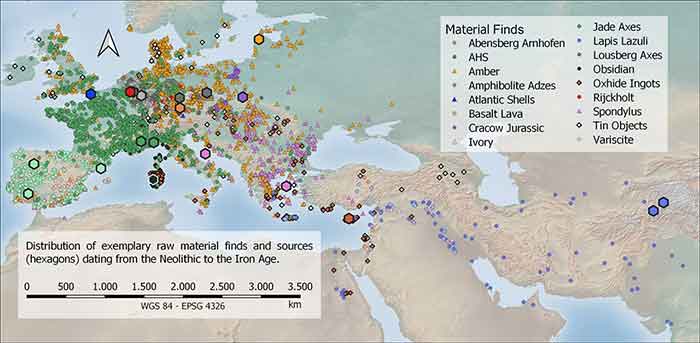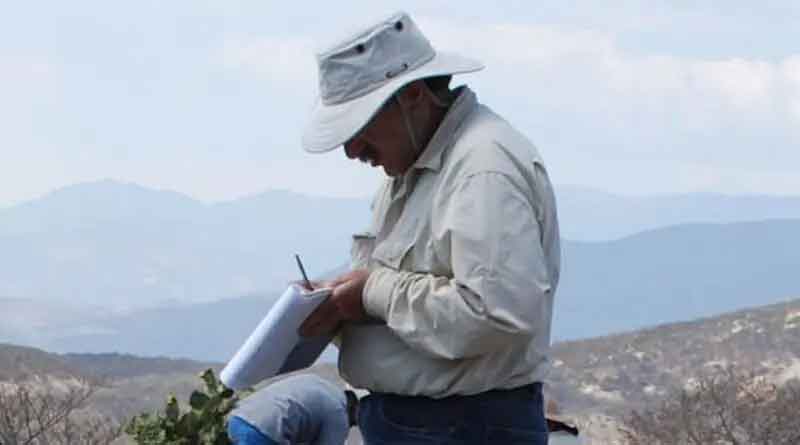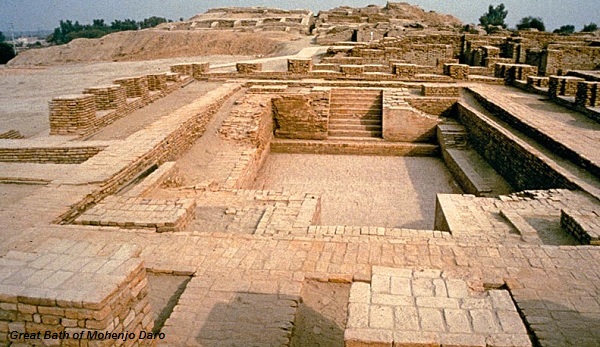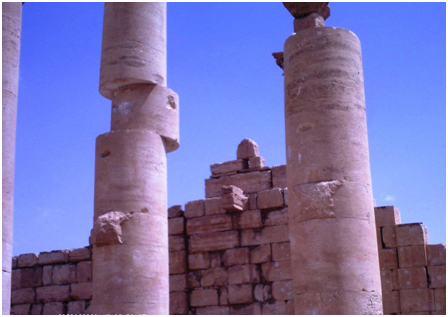An international group of researchers and data scientists are creating a comprehensive database of the world’s archaeological knowledge—and changing our understanding of humans’ prehistoric heritage.

Archaeology isn’t what it was in Indiana Jones’s heyday. The traditional image of the khaki-clad researcher scrambling over an excavation site with rock hammer and camel-hair brush has been supplemented by aerial and satellite photography, CT scanners and 3D modeling, and lidar that can isolate the smallest details of long-buried settlements. What archaeologists do with the artifacts and data they gather is changing dramatically as well, as they use network science and new software tools to map the complex connections between regional economic networks in the millennia before written history.
With this new, technology-driven approach, researchers can form a far more comprehensive picture of early communities’ ties with other human clusters sometimes thousands of miles away, by examining the goods and raw materials they exchanged and tracing these from their points of origin to the far-flung places where they were abandoned and then rediscovered centuries later. This is yielding additional insights into social inequality and power relations within communities, differences and similarities between communities living next to each other, and patterns of migration and settlement.
“You get more of a sense of a dynamic,” says Tim Kerig, an archaeologist at Kiel University’s ROOTS Cluster of Excellence in Social, Environmental, and Cultural Connectivity in Past Societies, in Germany, “of people coming from other places and how, over the generations, they filled that landscape. So we’re looking at the whole system, over not centuries but millennia.”
Network science is the study of complex relationships—and probable relationships—between physical, biological, social, and cognitive phenomena. Applying network science to archaeology was an idea in the minds of researchers as far back as the 1960s, says Kerig, whose own work focuses on the European Neolithic period—from about 8000 BC to 2000 BC—and the evolution of social inequalities. But while interest grew in succeeding decades, archaeologists lacked the tools to easily collate and analyze the millions of data points that had been gathered over many decades. The few efforts to do so proceeded punishingly slowly, on top of which, there was less interest at the time in exploring the connections that material and economic exchanges between far-flung communities could reveal.
“Sociological questions were mostly answered by looking at goods that were found in graves—the ‘sphere of kings’—which tended to be highly valued luxury items,” Kerig says, while archaeologists were less interested in “the daily stuff”: fragments of flint or stone objects or implements that made up the fabric of most people’s everyday lives. This was partly due to an overabundance of these humbler items. “Don’t forget that at a Stone Age site in Denmark, for example, you might have 100,000 artifacts to deal with, and they all look to most of us exactly the same.”
“Big Exchange” is the name of a project that an international cluster of scholars and data scientists, including Kerig, launched in 2020 with the aim of using digital tools to break down the barriers to applying network science to archaeology. The most critical hurdle they faced was overspecialization. Traditionally, archaeologists have focused on specific objects or raw materials—amber, obsidian, jade, flint, other metals—rather than the totality of findings at a given site, which prevented them from seeing the totality of that community’s networks of exchange. Big Exchange’s first objective is to create a database that collates all these materials and makes them available for more sophisticated, cross-referenced study and analysis.
“The approach of our project is to include all recordable raw materials, their find locations and places of origin in the analysis for the period from the end of the Middle Stone Age [or Mesolithic, 10,000 years ago,] to Antiquity,” Johanna Hilpert, a Big Exchange postdoc researcher at the ROOTS Cluster, told Phys.org in July 2023. “This can only be done by means of network analysis and with AI [artificial intelligence].”
A Deeper, More Granular Understanding
As of July 2023, Big Exchange has already collated data from 6,000 sites from which millions of artifacts have been recovered, and expects to complete the task in another two and a half years. The objective is to collect and digitize as much information as possible and establish classifications for all of it—for example, by site location, time period, and how far a material was found from its place of origin.
Establishing the database itself has not proven to be an easy task. Some of the source data for Big Exchange had already been digitized in some form; some of it is being digitized for the first time. It quickly became clear that the way researchers analyze these findings has changed over the past hundred years, “and so you can imagine all kinds of technical problems,” Kerig says.
Big Exchange used PostgreSQL, a common relational database management system. Working bottom-up, they started by inputting the individual datasets, developing the formal structure of the database, including comparisons of attributes and concepts, as they went along. Once all existing data is integrated, the database can be used by researchers working to reconstruct long-vanished economic and social networks.
But the project is already producing results. One study, published this year in the journal Antiquity, analyzed the geographic expansion of one of the most studied Neolithic cultures, the Linear Pottery culture (LPC) that extended from roughly the present-day Netherlands to the Black Sea and flourished from about 5500 BC to 4500 BC.
Applying a heterogeneous information network (HIN) analysis—a sophisticated graphic model that can map the relationships between diverse but interconnected sets of data—to raw materials in circulation at the time, researchers were able to detect differences in material culture between the northwest subgroup of the LPC and other subgroups that surrounded it. For example, sites associated with the northwest group contained no shells of Spondylus, a bivalve mollusk, that were a prestige good in Neolithic burial sites farther east in the Carpathian Mountains.
Previously, researchers assumed this was because of poor conditions for preservation in the area that the northwest group occupied. But HIN mapping revealed that the region lacking Spondylus shells was much wider than the area where preservation was difficult, and that it contained a good supply of flint that had originated much farther west. This suggested that the blend of raw materials used by the northwestern group wasn’t dictated by local availability, but by cultural or economic choice, linking the group to exchange networks that other LPC subgroups didn’t participate in, in spite of the fact that those other subgroups were close neighbors.
The HIN analysis allowed the Big Exchange researchers to develop a deeper, more granular understanding of the LPC—a culture that archaeologists thought they had already acquired a detailed knowledge of—that teases out previously undetected cultural and economic differences between subgroups.
Combining Big Exchange’s practice of looking at all the objects found at a particular excavation site with its focus on networks of exchange, the project is also producing new insights into inequality and power relations within groups. “The meaning of these objects changes depending on the regional and chronological context,” says Kerig. For instance, a fragile item found in a protective leather wrapping, with no evident practical use, will tend to come from a greater distance than more common items, indicating that a distant origin and the difficulty of obtaining it conferred a prestige value on the object. A large finding of such objects would indicate that an elite was emerging in the community connected with that site.
Clearing Away Cultural Bias
Already, however, the researchers are confronting limitations in the data they are collecting: limitations that point to larger issues. The vast majority of known archaeological sites outside the Americas are in Europe and, to a lesser extent, the Near East—a comparatively small area—with far fewer elsewhere, Kerig notes. Exchange networks in the Neolithic era certainly stretched far beyond these two regions. The more connections revealed by projects like Big Exchange, the more urgent will be the need to expand excavation and recovery into other parts of Eurasia; one goal of Big Exchange is to offer guidance as to where the most promising sites might be located.
Cultural bias is another issue. “We are not only collating datasets; we are also collating the authors of the datasets,” Kerig says. For some sites that he and his colleagues wanted to include, no actual data is available; perhaps research began in those areas but then was interrupted, or else documentation was lost during wartime, and all that remains are published or unpublished writings, often with less quantitative content and heavily informed by the preconceptions of the time. While evidence can be teased out of these sources, it has to be handled with care.
“These more qualitative things are very, very important—perhaps worth more than the actual datasets,” says Kerig. “But we meet regularly to discuss these things, and it’s new for all of us. I would expect that we will get a bloody nose if we don’t.” This is where technologies like artificial intelligence could become more useful in the future, by helping researchers to tease out valid observations from the mass of culturally biased material.
Big Exchange’s most pressing challenge, however, is keeping the project going. The painstaking work of inputting and mapping data into the project’s evolving database is currently being carried out by students at the Kiel ROOTS Cluster. “It’s a very labor-intensive thing,” says Kerig. He is now looking for a long-term home for Big Exchange that can host its growing data-analytic treasure trove and make it available to archaeologists and other investigators in coming decades.
But he remains hopeful about Big Exchange’s future. “I am pretty sure that something is coming in in this direction,” he says.
Eric Laursen is an independent journalist, historian, and activist. He is the author of The People’s Pension, The Duty to Stand Aside, and The Operating System. His work has appeared in a wide variety of publications, including In These Times, the Nation, and the Arkansas Review. He lives in Buckland, Massachusetts.
This article was produced by Human Bridges, a project of the Independent Media Institute.
















































